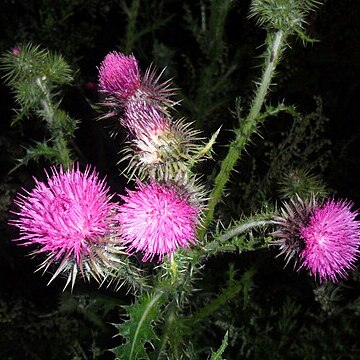Herbs 1-1.5 m tall, perennial. Stems erect, branched, unwinged, with long multicellular hairs. Leaves concolorous, green, abaxially glabrous or sparsely cobwebby and with long multicellular hairs, adaxially rough and sparsely to densely spinulose. Middle cauline leaves sessile, oblanceolate, 15-20 × 3-9 cm, pinnatipartite, semiamplexicaul; segments ca. 10 pairs, ovate to elliptic, with unequal triangular teeth with 1-2 mm lateral spinules and a 3-5 mm apical spine, basal teeth sometimes spiniform. Upper cauline leaves similar but ovate to narrowly elliptic, segments or teeth with a 5-10 mm apical spine. Bracts ovate, margin spiny or with spiny teeth. Capitula corymbose. Involucre campanulate, 3-3.5 cm in diam., glabrous or sparsely cobwebby. Phyllaries imbricate, in ca. 7 rows, lacking wings and scarious appendage; outer and middle phyllaries 1.2-2.5 × 0.2-0.3 cm, basal portion triangular to lanceolate, apical portion subulate, 1-1.2 cm, and patent to reflexed; inner phyllaries linear-lanceolate, ca. 2.5 × 0.2 cm, apex long acuminate. Florets bisexual. Corolla reddish purple, ca. 2.8 cm, tube ca. 1.5 cm. Achene dark, ca. 3.5 mm. Pappus bristles brownish, to 2 cm. Fl. and fr. Jul-Sep.
More
A herb. It is a thistle. It grows about 1 m high. The leaves near the base have stalks but the higher leaves do not and clasp the stem. The base leaves are deeply lobed with teeth and are strongly spiny. They have a cottony texture below. The flower heads are pinkish.
Cultivated areas, forest clearings, at elevations from 740-2,200 metres. Slopes, forests and forest margins; at elevations from 2,900-3,900 metres.
More
It is a temperate plant. Plants grow throughout Nepal between 700-3100 m altitude.

